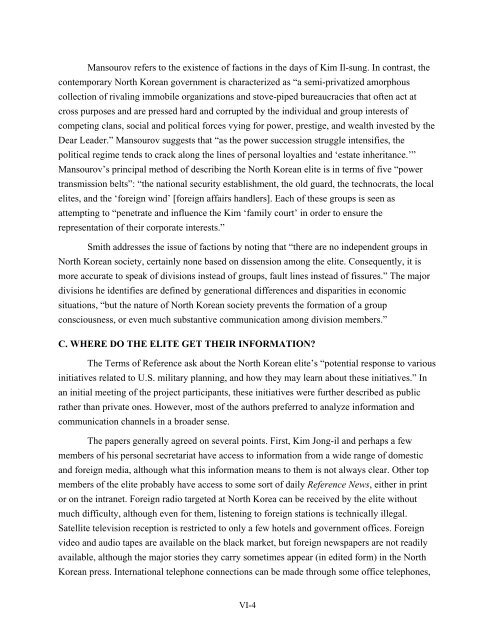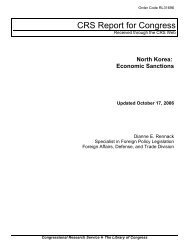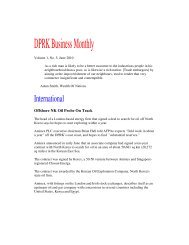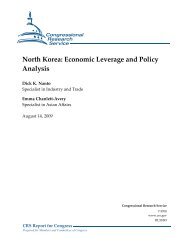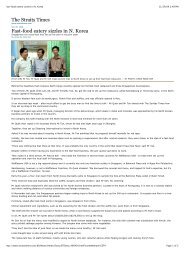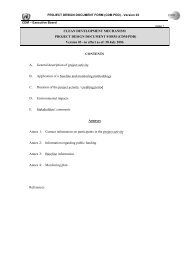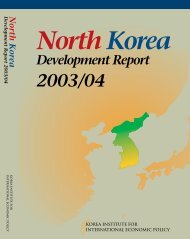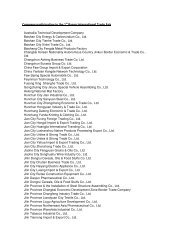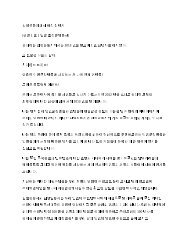North Korean Policy Elites - Defense Technical Information Center
North Korean Policy Elites - Defense Technical Information Center
North Korean Policy Elites - Defense Technical Information Center
Create successful ePaper yourself
Turn your PDF publications into a flip-book with our unique Google optimized e-Paper software.
Mansourov refers to the existence of factions in the days of Kim Il-sung. In contrast, the<br />
contemporary <strong>North</strong> <strong>Korean</strong> government is characterized as “a semi-privatized amorphous<br />
collection of rivaling immobile organizations and stove-piped bureaucracies that often act at<br />
cross purposes and are pressed hard and corrupted by the individual and group interests of<br />
competing clans, social and political forces vying for power, prestige, and wealth invested by the<br />
Dear Leader.” Mansourov suggests that “as the power succession struggle intensifies, the<br />
political regime tends to crack along the lines of personal loyalties and ‘estate inheritance.’”<br />
Mansourov’s principal method of describing the <strong>North</strong> <strong>Korean</strong> elite is in terms of five “power<br />
transmission belts”: “the national security establishment, the old guard, the technocrats, the local<br />
elites, and the ‘foreign wind’ [foreign affairs handlers]. Each of these groups is seen as<br />
attempting to “penetrate and influence the Kim ‘family court’ in order to ensure the<br />
representation of their corporate interests.”<br />
Smith addresses the issue of factions by noting that “there are no independent groups in<br />
<strong>North</strong> <strong>Korean</strong> society, certainly none based on dissension among the elite. Consequently, it is<br />
more accurate to speak of divisions instead of groups, fault lines instead of fissures.” The major<br />
divisions he identifies are defined by generational differences and disparities in economic<br />
situations, “but the nature of <strong>North</strong> <strong>Korean</strong> society prevents the formation of a group<br />
consciousness, or even much substantive communication among division members.”<br />
C. WHERE DO THE ELITE GET THEIR INFORMATION?<br />
The Terms of Reference ask about the <strong>North</strong> <strong>Korean</strong> elite’s “potential response to various<br />
initiatives related to U.S. military planning, and how they may learn about these initiatives.” In<br />
an initial meeting of the project participants, these initiatives were further described as public<br />
rather than private ones. However, most of the authors preferred to analyze information and<br />
communication channels in a broader sense.<br />
The papers generally agreed on several points. First, Kim Jong-il and perhaps a few<br />
members of his personal secretariat have access to information from a wide range of domestic<br />
and foreign media, although what this information means to them is not always clear. Other top<br />
members of the elite probably have access to some sort of daily Reference News, either in print<br />
or on the intranet. Foreign radio targeted at <strong>North</strong> Korea can be received by the elite without<br />
much difficulty, although even for them, listening to foreign stations is technically illegal.<br />
Satellite television reception is restricted to only a few hotels and government offices. Foreign<br />
video and audio tapes are available on the black market, but foreign newspapers are not readily<br />
available, although the major stories they carry sometimes appear (in edited form) in the <strong>North</strong><br />
<strong>Korean</strong> press. International telephone connections can be made through some office telephones,<br />
VI-4


